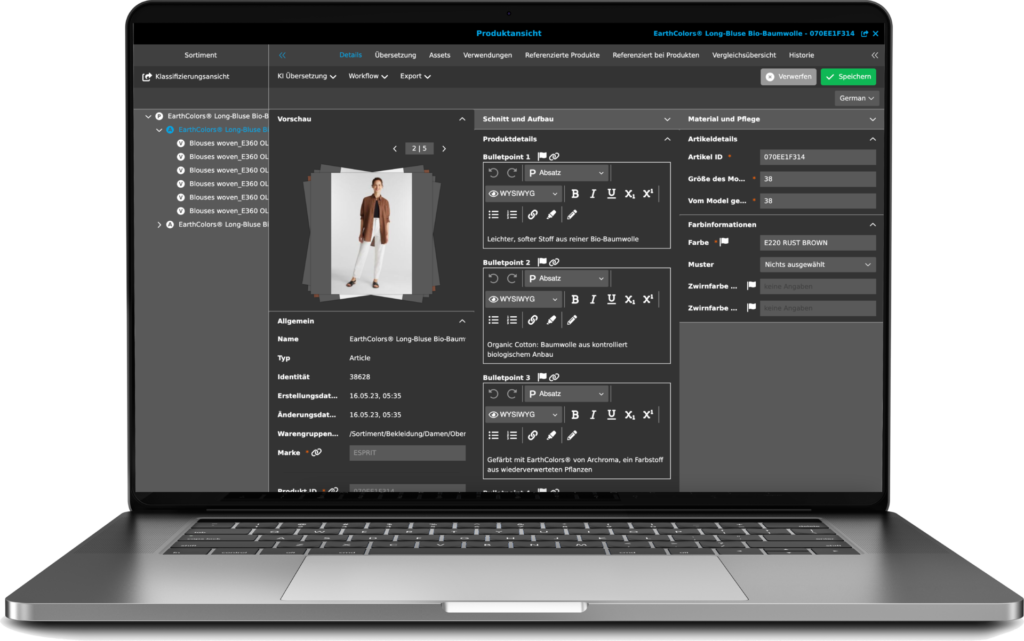The History of PIM
Product Information MANAGEMENT
The evolution of Product Information Management (PIM) is a fascinating journey through time, closely linked to the progress of information technology and the changing demands of the market. This article highlights the milestones in this development and shows how PIM systems have become an indispensable part of modern corporate strategies.
PIM systems have become an integral part of the world of e-commerce and digital product information – but this was not always the case. In the early days, there was a veritable proliferation of terms that ended in three-letter abbreviations such as MDM or MAM. Basically, it was always about Cross-Media Publishing (CMP) or Database Publishing (DBP), i.e. the management and publication of content across different media channels and databases. Although PIM systems are the preferred solution for managing product data today, we should not forget that the foundation of their success was laid by DAM systems. They were pioneers in structured data management and content management, and PIM systems have built on these foundations to develop into what they are today – an indispensable tool for the digital presentation of product information.

The history of PIM: the beginnings in the 1980s and 1990s
The history of PIM begins in the 1980s, when companies primarily relied on paper catalogs and manual processes to manage their product information. Digitization was still in its infancy and data management was mainly carried out using spreadsheets, simple databases or even on paper. These methods were time-consuming, error-prone and inefficient, especially for companies with a broad product portfolio.

The Influence of the Internet in the late 1990s
With the advent of the Internet and e-commerce platforms in the late 1990s, the need to organize and manage product information digitally grew. Companies recognized the importance of consistent and accurate product information for online sales. This led to the development of the first PIM systems, which aimed to store and manage product information centrally and distribute it via various channels. However, the first PIM systems were often customized solutions.

DAM Systems pave the Way
During this time, digital asset management (DAM) systems played a decisive role. Originally designed to organize digital media such as images, they provided the structure and processes that would later serve as the basis for PIM systems. Companies realized that the efficient management of product information required similar systems that went beyond the management of media.

The 2000s: Integration and Multichannel Management
The first specialized PIM systems arose from the need to manage not only media, but also detailed product information such as prices, dimensions, colors and technical specifications. However, in the new millennium, with the further spread of the Internet and the development of Web 2.0, not only did the provision of comprehensive product descriptions, reviews and comparison options become increasingly important, but the integration of various sales and marketing channels came into focus. The complexity of product information management increased and PIM systems evolved into comprehensive solutions that could not only store product information, but also optimize it for a variety of channels such as online stores, print catalogs, mobile applications and more. The ability to provide consistent and high-quality product information across all channels has become a critical success factor in competition.

The 2010s: The Era of the Smartphone
The rise of the smartphone and the digitalization of product information in the 2010s heralded the slow end of traditional print catalogs. Product information became accessible in pocket format, everywhere and around the clock. In addition, smartphones expanded the use of social media, putting the customer even more at the center of attention. Click behavior and customer experience have become key components of marketing. PIM systems have had to adapt to not only manage product information, but also integrate customer-oriented content such as instructions, videos and FAQs. PIM systems have become smarter, with data analysis and enrichment capabilities to enable personalized customer experiences.

Today and the Future: AI and Automation
Today, PIM systems are far more than just databases for product information. They are the backbone of the customer experience that companies offer their customers. However, PIM systems are currently on the threshold of a new era characterized by artificial intelligence (AI) and automation. Modern PIM solutions use AI to identify patterns in data, make predictions, further improve data quality and optimize the product experience across all touchpoints. The future promises even more integration for a 360-degree view of the customer and the product. It’s an exciting time for PIM systems as they are at the forefront of technological development to revolutionize the way companies present and sell their products.
Conclusion on the History of PIM
The journey of PIM systems is a prime example of how technology can help solve complex problems and transform business processes. From its humble beginnings to the powerful platforms of today, PIM has undergone a metamorphosis that underscores the importance of data management and quality in today’s digital economy.
About OMN PIM
OMN PIM is our Product Information Management (PIM) system. With OMN PIM you can collect, structure and process product data from various sources. Regardless of whether the data comes from external or internal sources. Created specifically for product information, OMN PIM is therefore the ideal place for all your product data along the entire supply chain. Whether master data, specifications, materials, manufacturing processes or product compliance details, OMN PIM bundles and links them all in a central location. Structured digital processes and functions for data governance and version control ensure transparency, sustainability and compliance. In addition, OMN PIM already uses AI today. Various AI services integrated into OMN PIM ensure that you get the maximum level of automation in the preparation and digital presentation of your product data. See the power of OMN PIM for yourself – free of charge and with no obligation.

Would you like to get to know our OMN PIM?
EXPERIENCE OUR PIM LIVE AND SEE ITS PERFORMANCE FOR YOURSELF!